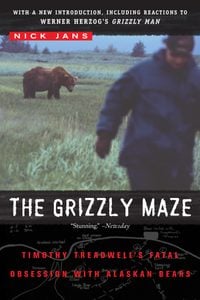This Man Protected Wild Bears Every Day for 13 Years—Until He Made the Ultimate Sacrifice
Updated: Feb. 14, 2023
The bear was 20 feet away, head low, moving slowly but instead of retreating, it stared straight at them and stepped forward.
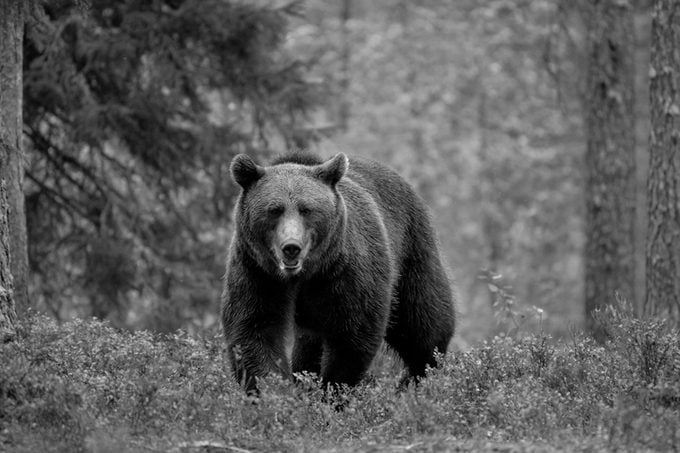
Timothy Treadwell was the sort of guy most Alaskans loved to hate. For starters, Treadwell was an outsider, a Californian from the weird-wacky end of the scale, a guy sporting a shock of blond hair and a backward baseball cap, with the outdoors skills you’d expect of a former Malibu cocktail waiter. Then there was the way Treadwell acted around bears. Lots of Alaskans would like to get a bear in their rifle sights; Treadwell sang and read to the grizzlies on the rugged Katmai Coast, and gave them names like Thumper, Mr. Chocolate, and Squiggle. He would walk up to a half-ton wild animal with four-inch claws and two-inch fangs, and say, “Czar, I’m so worried! I can’t find little Booble.” In Alaska, that kind of behavior makes a man stand out—and not in a good way.
Treadwell had been a fixture along the Katmai Coast for 13 years, camping out each spring and summer, alone, in the heart of bear country, deliberately seeking out the animals. He told the story of how this came about in his book, Among Grizzlies. By Treadwell’s account, he was born into a middle-class family on Long Island, New York. He wasn’t really a bad kid, but a handful. All along, he sensed a kinship with animals; he “donned imaginary wings, claws, and fangs.” As an adolescent, he did more than his share of drinking, wrecked the family car, and managed to get arrested. After high school, he left home for California, where he became “an overactive street punk without any skills, prospects, or hopes.” He slid into hard-core drug use and was plucked back from the edge by a Vietnam vet with a heart of gold, who slapped him into shape and pointed him toward Alaska and bears.
There he discovered his true purpose in life: watching over those noble and imperiled creatures. The way he told it, he had stumbled onto a peaceable kingdom where the bears seemed neither ferocious nor afraid of man—a childhood dream made real. Photos and videos document the breathtaking proximity to the animals that he was able to achieve. Not only did they not attack, but they seemed to give a collective ursine shrug and accept him as a somewhat odd-smelling and harmless hanger-on.
Crawling on all fours, singing and talking in that sort of odd, high voice normally reserved for babies and small dogs—”Hey, little bear, love you, aren’t you beautiful, that’s right, love you”—Treadwell sidled up to wild bears, his camera and video recorder whirring, and he filled notebooks with observations, scrawled in wavering schoolboy print. Some of the animals, he maintained, seemed to actually enjoy his company. A wounded bear he named Mickey slept near his tent for weeks and recovered; mother bears would leave their cubs nearby when they went off to forage as if asking him to babysit. By his own admission, he even went so far as to plant a kiss on one bear’s nose after it licked his fingers.
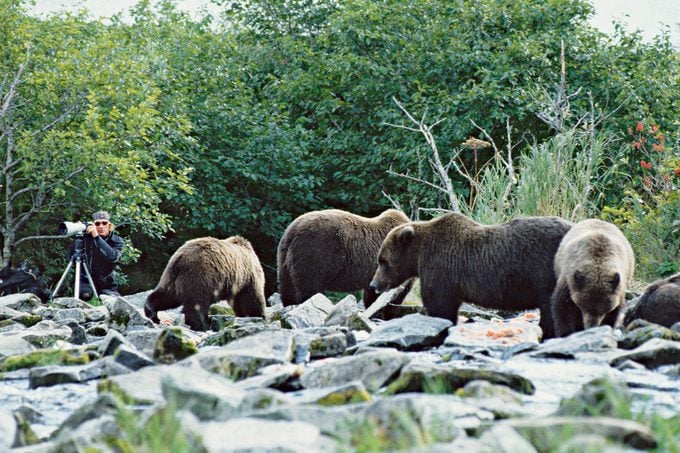
Treadwell had found love, so powerful it bordered on obsession. He called the objects of his affection grizzlies, but they were and are considered by Alaska biologists to be brown bears, the coastal version of the species Ursus arctos. The inland variation is commonly known in North America as grizzly (Ursus arctos horribilis). The distinction between grizzlies and brown bears is, most Alaskans would argue, the difference between pit bulls and Labrador retrievers. But Treadwell chose to call his bears grizzlies for reasons any publicist could explain, and justified it in print by rightly claiming they were the same species.
In the history of the Katmai National Park and Monument, stretching back over 85 years, not one person had been seriously mauled, let alone killed, by a bear. Still, these huge animals are far from harmless. At least twice, Treadwell was reduced to a quaking ball of nerves. In one case, witnessed from a distance by a bear-viewing guide in the mid-’90s, an older male bear who was courting a female lost his temper at Treadwell and stopped just short of knocking his head off. Another time, threatened by a bear trashing his tent, Treadwell made a radio call in a total panic to a local air service, asking for an immediate fly-out from the area.
Treadwell never carried a gun and maintained that even if firearms had been legal in the park, he still wouldn’t have carried one. Early on he swore off nonlethal means of protection, like the newly developed (and highly effective) portable electric fences, and even pepper spray. The spray he did use once, when he felt he had no other choice, hosing a bear he’d named Cupcake; he was so distressed by the bear’s apparent agony that he vowed he’d never use repellent again. Fear, he decided, wasn’t the message he wanted to send. Good intentions were the only shield he needed.
‘You’re going to get yourself killed’
At the end of each of those first few summers, Treadwell returned to Malibu. He and Jewel Palovak, his friend and co-author, put serious time into discussing how they might turn his burgeoning passion for bears into something more. Treadwell sold photos at crafts fairs, and he began doing free presentations for elementary school students.
He loved the children as much as they loved him. With his own kidlike enthusiasm, jumping up and down and having the kids repeat bear facts after him, he was a natural. What’s more, the youngsters were learning about bears, and coming to care about them too. Thus the idea of Grizzly People was born: a grass-roots, nonprofit organization with a professionally designed website, dedicated to protecting the bears, studying them and educating people. Palovak claims that Treadwell reached about 10,000 school-children a year. The letters from excited kids and grateful, impressed teachers poured in.
Not everyone approved of what he was doing. Regulations for Katmai stipulate viewing distances of no less than 50 yards for brown bears. Both Treadwell’s personal videos and professional productions featuring him document distances far closer than that, which angered and alarmed conservationists. Several local people resented this surfer boy with wraparound shades telling them what to do with their bears. As to his claims that the bears were endangered, not even the most greenie locals would go along with such an idea.
The bear science establishment disdained his methods; one researcher described Treadwell’s interaction with bears in the field as “his own private Jackass show,” a reference to the sophomoric MTV program that features a series of mindless, often death-defying stunts. Longtime state bear biologist Sterling Miller recalls admonishing Treadwell to be more cautious.
Treadwell wrote back saying that he would personally “be honored” to end up as grizzly scat—though that was not exactly the word he used. Says Miller, “Given his attitude, I believed it wouldn’t be long before he was so honored.”
Tom Walters, the plain-spoken head of bear-viewing guides at Katmai Wilderness Lodge, of which he is also a part owner, says, “I told him straight out, years ago, he was going to get himself killed.”
Strange season
Amie Huguenard saw Timothy Treadwell in Boulder, Colorado, at a slide show and lecture he gave in 1996 at the University of Colorado campus. She was smitten by his passion and commitment and later wrote to him. One thing led to another, and they became romantically involved. At the time of their first meeting, she was in her early 30s, a surgical physician’s assistant, attractive in a wholesome, fit way.
She had spent a couple of weeks with Treadwell in Alaska in the two summers before 2003. This year’s visit was different; there was an evident strain. For one thing, this late in the season—the end of September—it was a challenge to keep warm and dry while camping in the autumn rains with the first snows around the corner. Then there were the bears. Treadwell’s camp, a short distance from the shore of Upper Kaflia Lake, was on a grass-crowned knoll amid a labyrinth of tunneled trails that bears had worn through the dense brush over centuries. Treadwell called this place the Grizzly Maze. Huguenard’s anxiety at being there showed on a video that Treadwell shot; in one sequence, she sits in the brush with a female bear and cubs ten feet away. Then one bear shifts even closer. Huguenard’s face is taut and unsmiling. She wanted to pull back, not push to get so close.

She was frightened. They argued. Treadwell tried to reassure her. You can practically hear him saying, “Everything’s fine. It’s only Tabitha.” But in fact, everything wasn’t fine. Five miles away as the crow flies, bear biologist Matthias Breiter was camped out with a small party of photographers. The bear dynamics he observed were both chaotic and unusual. In a normal year, the half-mile of creek before him might have had 15 bears working for fish; this year, more than 60 showed up. The crowding led to conflict. “You’d usually see four fights a week,” says Breiter. “It was ten a day. Real, all-out fights. The level of aggression was far above normal.”
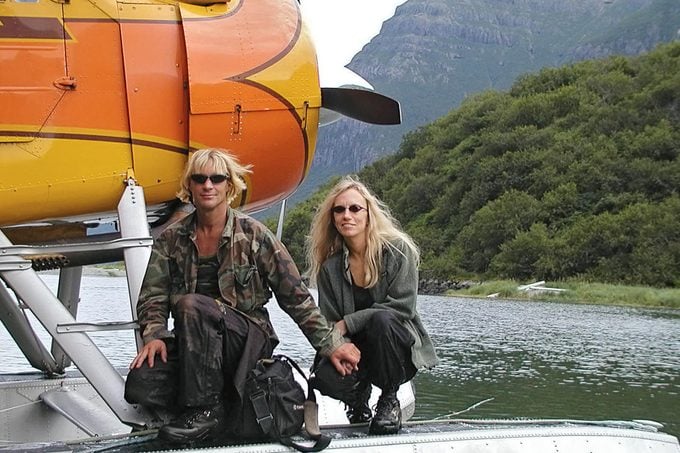
The reason was deceptively simple. Due to freak weather conditions, the berry crop along the Katmai Coast had failed; the bears depended on berries to supply calories for their winter hibernation survival. At the same time, the salmon runs were at least average, or even above normal. Space at the best salmon-fishing spots was limited, and turmoil resulted.
When the salmon run in Breiter’s valley petered out in the third week of September, the bears simply hiked over the pass to Kaflia Bay, where, due to local factors, the salmon run was slightly later and more prolonged. Kaflia already had more than its share of bears wrangling along the creek just 300 yards from Treadwell’s camp. Normally the rocky creek bed would be littered with fish parts or entire carcasses with just a bite or two removed. But in this strange season, the bears, scrounging desperately, had eaten every scrap of fish they caught. Tensions ran high as resident bears clashed with interlopers and each other.
If Treadwell sensed the growing peril, he gave little sign. One video, taken at the camp, features him explaining to the camera that this is a dangerous place, but they’ll be safe here. He knows these bears.
‘It was a combat-ready situation’
When pilot Willy Fulton landed on Upper Kaflia Lake at the hour he and Treadwell had arranged—2 p.m. on October 6, 2003—things didn’t seem right. He was expecting the usual neat pile of gear down by the water’s edge, ready for a quick load and fly-out, but no equipment was visible. And Treadwell had not made his customary contact with his handheld VHF radio as the plane approached.
Fulton tied up the plane and headed through the brush to the camp, calling Treadwell’s and Huguenard’s names. Silence. “About halfway up, I got kind of an odd feeling,” he says, “and decided to go back to the plane.” He wanted to take off, look things over from the air.
Pausing to untie his plane, Fulton glanced over his shoulder. Behind him was a bear, coming fast and low, eerily silent, 20 feet away. As the pilot leapt to his floats and pushed off, the bear was a body length behind. Fulton scrambled into the cockpit and slammed the door. The bear, a big, dark male, skidded to a stop at the water’s edge, eyes still fixed on him. Huffing, the animal paced the bank as the plane drifted out into the lake.
“I’ve been charged by a few bears, but this was different,” Fulton says.
“He wasn’t acting big and bad. He was crouched down, sneaking up on me. That look in his eye was different too. Right then I felt like he was out to kill me and eat me.” Fulton’s heart was thumping. The Beaver’s engine rattled to life, and the bear disappeared.
Circling the camp, Fulton could see the tents, still staked out but mashed flat. And in front of one he saw a large bear, the same one, he figured, feeding on something. It looked, chillingly, like a human rib cage.
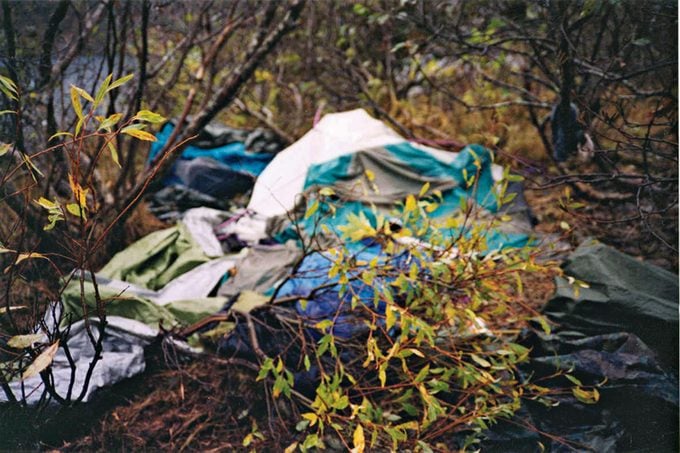
Fulton contacted his operations manager, who alerted the state troopers in the town of Kodiak on the island of the same name. The manager also contacted the park service in King Salmon, which is on the mainland, about 75 miles west of Kaflia on the far side of the Alaska Peninsula. The park service rangers advised Fulton to wait where he was. Soon two planes were airborne, one carrying two rangers and a pilot, the other with two troopers.
By the time the park service plane arrived, Willy Fulton had been anxiously waiting for three hours. He jumped into the park service’s Cessna and they taxied the mile east toward the campsite. District ranger Joel Ellis recalls, “We got out of the plane in a combat-ready situation, yelling for the people.” The shouting was also to drive away any bears in the area.

The four men moved forward, hands clenched around guns, along the steep, narrow trail rising through the alders. Suddenly Allen Gilliland, the park service pilot, shouted, “Bear!” It was less than 20 feet away, head low, moving silently toward them. Everyone yelled repeatedly, throwing all their pent-up emotion into it, trying to haze the big male away. But instead of retreating—as almost any bear would from a tightly packed, aggressive, loud group of humans—he stared straight at them and stepped forward.
“He had that same look in his eye,” Willy Fulton recalls. “I think he meant to kill all of us.”
Ellis remembers, “We didn’t confer. We just started shooting.” Fulton, who was between the other men and the bear, dived to the ground as the fusillade exploded overhead. The big bear dropped in his tracks, twitched, let out one last breath, and was dead.
State Troopers Alan Jones and Chris Hill had just landed and were tying their plane down by the lake when they heard the volley. They hurried toward the noise. In the meantime, the park service team and Fulton made their way to Treadwell’s campsite. The two tents were crushed down but intact. In front of one tent was a large mound of mud, grass, and sticks.
There in the muck was what Ranger Ellis later called, his voice tight, “fresh flesh”—fingers and an arm protruding from the pile. With unmistakable evidence of at least one fatality, the investigation was officially handed over to the Alaska State Troopers, who had just arrived at the campsite. Trooper Hill was in charge. A perimeter check around the campsite turned up what was left of Timothy Treadwell. The face, recognizable and uncrushed, was caught in a grimace. Meanwhile, searchers excavating the bear’s cache back in camp had discovered Amie Huguenard’s remains. Her face was also intact; she might have seemed peacefully asleep except that her body, like Treadwell’s, had been mostly eaten.
As the men put the remains into body bags and packed up Treadwell and Huguenard’s gear, Trooper Hill yelled, “Bear!” It was a much smaller animal. As it continued toward them, the men had all had enough. Hill and Ellis opened fire. Allen Gilliland also shot twice, then moved in and made a killing shot to the base of the animal’s skull.
It was now after 6 p.m. One by one, the three planes took off in the dusk. Six men rode the currents of the sky, rising away from the darkness and death. But Kaflia would follow them the rest of their lives.
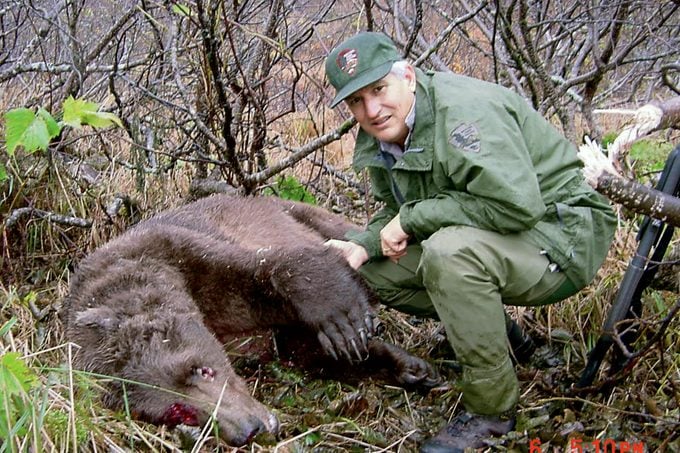
‘Come out here! I’m being killed!’
Anecropsy—an examination of the dead bears’ stomach contents—showed that the big bear had human remains and clothing in its digestive tract. The small bear had been mostly eaten by other animals, but its remains showed no evidence of its having taken part in the killings.
Little would be known about the exact circumstances of Treadwell’s and Huguenard’s deaths had Trooper Hill not made a stunning discovery. Among the couple’s effects was a digital camcorder; listening to the tape, Hill came upon a chilling audio sequence of Timothy and Amie’s last moments.
“Come out here! I’m being killed out here!” Treadwell screams to Huguenard. Inside the tent, Amie has had the presence of mind to reach in the camera bag and turn the video recorder on with the attack in progress. They’ve been filming for days, and it may be an automatic reaction. Maybe, too, she realizes, this is it, and like anyone facing death wants to reach out toward the living one last time. The tape became her message in a bottle.
The sound of a zipper is evident on the tape: the noise of the tent opening. Amie screams to Timothy, “Play dead!” Obviously, she understands what Timothy, in his desperation, does not: There is nothing she can do to help him. The speed and force of an attacking grizzly is overwhelming. Like being hit by a truck doing 60. Or an avalanche.
“Play dead!” Amie cries again. It must take incredible, almost superhuman discipline to lie there, ripped apart and bleeding, with an enormous animal tearing and thrashing at you. But it seems to work for a time. The bear breaks off the attack; words pass back and forth as Timothy and Amie try to determine if it’s really gone. At this point, Amie may have rushed to Timothy’s rescue. She was a surgical physician’s assistant, after all, used to seeing things that would make other people blanch, trained to keep cool under pressure. And this was the man she loved.
But the sounds on the tape indicate the bear’s return. Amie is forced to retreat. Timothy shrieks that playing dead isn’t working, and he begs her to get something and hit the bear.
“Fight back!” she screams. There seems to be the sound of an object being thrown.
Treadwell did not die quickly. The tape runs roughly six minutes, and his cries can be heard two-thirds of that time. He was not one of those people who float off into a shock-induced dream state. He was sharply aware and struggling desperately to survive. The bear, as is often the case, is nearly silent—no Hollywood roars, only low growls and grunts—which adds to the horror. Dragging sounds and the fading of Timothy’s cries seem to indicate he’s being pulled off into the brush, his fate now sealed.
The last sounds on the tape—Huguenard’s repeated, high-pitched screams—are “eerily like a predator call,” wrote Larry Van Daele, a wildlife biologist for the Alaska Department of Fish and Game. He was referring to a device carried by hunters to produce the distress cries of a small, wounded animal, which often attracts bears. He theorized that those shrieks “may have prompted the bear to return and kill her.” After what she’d seen, enough to break anyone, it was easy to envision her rooted to the spot outside the tent, hysterical and paralyzed by fear until the bear returned.
The men played the tape again and again, paused and rewound, taking notes, blocking out scenarios, all the while trying to decipher sounds muffled by the tent walls, the camera case itself, and the incessant spatter of rain on the tent. Over and over they listened to the screams, unable to help.
Fundamental errors
Far from Bush Alaska, the story forged its own trail. Of course, the AP picked it up, and because of Treadwell’s Malibu connection, the Los Angeles Times provided extensive coverage. The editorial slant was generally less than positive. (“Brown bears were his life; he was their lunch,” a column in Field & Stream was titled.) Treadwell’s friends and supporters, especially Grizzly People co-founder Jewel Palovak, provided staunch, if not always effective, counter-fire. At one point Palovak was quoted as saying that Treadwell’s being killed and eaten was “the culmination of his life’s work”—a comment that was pounced upon by U.S. Geological Survey research ecologist Tom Smith, among others.
“Culmination?” Smith asked. “If you consider yourself a friend to bears and want to project a positive image about them, how is getting two bears and yourself and your girlfriend killed a culmination of your life’s work?”
Palovak later admitted that in her initial shock and loss she “probably said some stupid things.” She remains committed to preserving Treadwell’s legacy. “I will do my best to portray what he thought, and to carry on the work of Grizzly People.” This means, she explains, continuing programs of bear education and finding ways to protect the animals.
Treadwell left her countless feet of videotape to catalog and organize, and what she calls “probably the biggest library of still images of brown/grizzlies in the world.”
Those searching for the meaning in what happened to Timothy Treadwell offer compelling theories, impossible to either prove or refute but containing flickers of insight. Bear-viewing guide Gary Porter says, “I think Timmy made a fundamental anthropomorphic error. Naming them and hanging around with them as long as he did, he probably forgot they were bears. And maybe they forgot, some of the time, he was human.” Porter points out that old, dominant males generally avoid people and are intolerant of other bears. A subordinate bear that refuses to move is attacked and, if it doesn’t retreat, is often killed and eaten. Biologist Larry Van Daele calls such an event “apparently more of a disciplinary action than predatory.”
And he, too, agrees there may be something to the theory, especially given “the strange, ambiguous signals Timothy sent to bears.”
“Maybe that big guy figured Timmy was just another bear,” Porter suggests. If so, it was a final, ironic compliment to a man who strove, among bears, to become as much like them as possible. In the end, even the shadow cast by the killings doesn’t negate the impact that Timothy Treadwell had on thousands of schoolchildren who shouted bear facts back to him in unison, wrote piles of letters and went home excited to learn more. His death was a shock, but maybe his life was a lesson to others about commitment to a cause. Conservation doesn’t occur in a vacuum, and our collective and benign tolerance of bears is far more critical and real an issue than their tolerance of us. They need us to preserve their habitat and protect them from slaughter—a threat especially in the Russian Far East. If bears are still walking the beaches of Alaska, the sedge fields of eastern Russia, and the pine forests of Montana a hundred years from now, it will be because people—including the children Treadwell touched—cared enough to make it happen.
